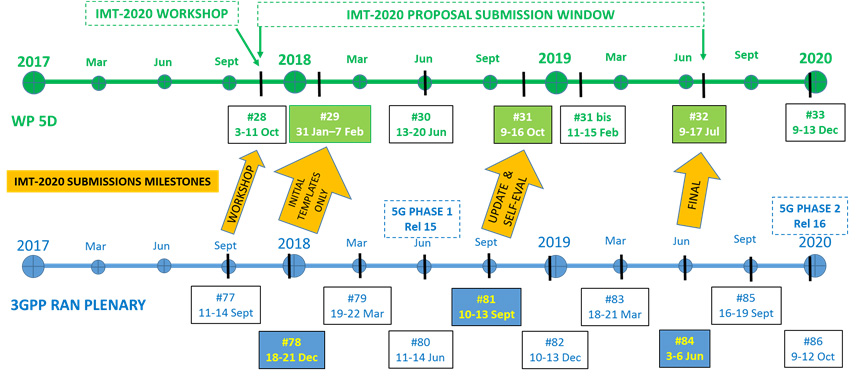3GPP Release 16
ITU-R Schedule for completion of IMT-2020.SPECS; Workshop Results
Schedule for Detailed specifications of the terrestrial radio interfaces of International Mobile Telecommunications-2020 (IMT-2020) – IMT-2020.SPECS:
Meeting No. 33 (Dec. 2019, Geneva)
- Develop a detailed work plan
- Develop a working document towards PDNR M.[IMT-2020.SPECS]
Meeting No. 34 (Feb. 2020, Geneva)
- Review the work plan, if necessary
- Continue developing the working document towards PDNR M.[IMT-2020.SPECS]
- Receive and take note of “Form A”, in order to determine the structure of the Recommendation
- Provide and send liaisons to RIT/SRIT Proponents and GCS Proponents
Meeting No. 35 (Jun. 2020, [China])
- Receive and review information, including the texts for its RIT/SRIT overview sections, List of Global Core Specifications and Certification B by GCS Proponents1
- Reach its conclusion on the acceptability of the proposed materials for inclusion in the working document towards PDNR M.[IMT-2020.SPECS]
- Finalizes the working document including specific technologies (not necessarily including the detailed transposition references) and provisionally agree for promoting the document to preliminary draft new Recommendation
- Provide and send liaison of the provisionally agreed Preliminary Draft New Recommendation ITU-R M.[IMT-2020.SPECS] to the relevant GCS Proponents and Transposing Organizations for their use in developing their inputs of the detailed references
Meeting No. 36 (Oct. 2020, [India])
- Update PDNR if there are modifications proposed by GCS Proponent
- Perform a quality and completion check of the provisionally agreed final draft new Recommendation ITU-R M.[IMT-2020.SPECS] without the hyperlinks
- Have follow-up communications initiated with GCS Proponents and/or Transposing Organizations, if necessary
Meeting No. 36bis (Nov. 2020, Geneva)
- Receive Transposition references and Certification C from each Transposing Organization
- Perform the final quality and completeness check (with detailed transposition references) of the preliminary draft new Recommendation and promotes it to draft new Recommendation
- Send the draft new Recommendation ITU-R M.[IMT-2020.SPECS] to Study Group 5 for consideration
1____________________ If the GCS Proponentrnal (potential GCS Proponent) decides to use DIS style, it doesn’t need to submit List of Global Core Specifications but needs to submit full materials for describing its RIT/SRIT in the Recommendation and Form B.
…………………………………………………………………………………………………………….
Workshop on IMT-2020 terrestrial radio interfaces evaluation (10 to 11 December 2019, Geneva, Switzerland):
ITU-R Working Party (WP) 5D started the evaluation process for Independent Evaluation Groups (IEGs) as of its 31st meeting in Oct. 2018, in conjunction with the ongoing IMT-2020 development under Step 3 and Step 4 of the IMT-2020 process.
Working Party 5D has received, at its July 2019 meeting, several candidate technology submissions for IMT-2020 from six proponents, under Step 3 of the IMT-2020 developing process.
WP 5D held a workshop on IMT-2020, focusing on the evaluation of the candidate terrestrial radio interfaces at its 33rd meeting taking place December 2019 in Geneva, at which interim evaluation reports are expected. This will help the IEGs understand the details of the proposed candidate technologies, and interact amongst themselves as well as other WP 5D participants. This workshop is a continuation of the previous one on IMT-2020 held in 2017, Munich, which addressed the process, requirements, and evaluation criteria for IMT-2020 as well as views from proponents on the developments of IMT-2020 radio interfaces and activities of the IEGs.
https://www.itu.int/en/ITU-R/study-groups/rsg5/rwp5d/Pages/ws-20191210.aspx
December 12, 2019 UPDATE:
See Comment in box below this article for disposition of TSDSI, ETSI/DECT Forum, and Nufront IMT 2020 RIT self evaluations. They have not “satisfactorily fulfilled Section 4.3 for the self-evaluation,” which means that the respective IMT 2020 RIT submissions will not be progressed at this time by WP 5D.
SK Telecom Selects Ericsson 5G Packet Core (3GPP Release 16- 5GC)
SK Telecom has selected Ericsson to deliver a Cloud Packet Core for its 5G network. Ericsson says its Cloud Packet Core (part of the company’s Cloud Core portfolio) helps service providers to smoothly migrate to 5G Core (5GC) stand-alone architecture.
Author’s Note:
Please see below for more information on 3GPP 5GC which is part of Release 16 and as yet has not been submitted to either ITU-R or ITU-T for IMT 2020 mobile packet core. There seems to be no independent work on a 5G mobile packet core within ITU, which is evidently waiting anxiously for 3GPP Release 16 to be completed and forwarded to various ITU-R WPs and ITU-T Study Groups.
………………………………………………………………………………………………………………………………………………………………………………………..
Ericsson’s Cloud Packet Core is at the business end of mobile broadband and IoT networks. It creates value, visibility and control of traffic and applications by determining the optimal quality of a service, then enforcing it through appropriate policy.
Jung Chang-kwan, Vice President and Head of Infra Engineering Group, SK Telecom, says: “By utilizing Ericsson’s Cloud Packet Core network solution, which realizes simplified network operations, we will unleash the full potential of new 5G-enabled use cases with greater efficiency.”
Jan Karlsson, Senior Vice President and Head of Digital Services, Ericsson, says: “This deal, and the opportunity to work with SK Telecom’s Network Functions Virtualization Infrastructure (NFVI), has put us in the ideal position to further strengthen their 5G network. Delivering our Cloud Packet Core solution will positively impact SK Telecom’s network operations and will reinforce Ericsson’s position as a leader in 5G core.”
SK Telecom switched on its commercial 5G network in December 2018 after selecting Ericsson as one of its primary 5G vendors. Previously, Ericsson provided radio access network (RAN) products, including mid-band Massive MIMO.
………………………………………………………………………………………………………………………………………………………….
3GPP 5GC (the only specification for a 5G mobile packet core):
The 5GC (5G packet Core), specified in 3GPP TS 23.501: System architecture for the 5G System (5GS); Stage 2, will be part of 3GPP Release 16, which won’t be completed till June 2020 at the earliest.
3GPP’s 5G System architecture is defined to support data connectivity and services enabling deployments to use techniques such as e.g. Network Function Virtualization and Software Defined Networking. The 5G System architecture shall leverage service-based interactions between Control Plane (CP) Network Functions where identified. Some key principles and concept are to:
– Separate the User Plane (UP) functions from the Control Plane (CP) functions, allowing independent scalability, evolution and flexible deployments e.g. centralized location or distributed (remote) location.
– Modularize the function design, e.g. to enable flexible and efficient network slicing.
– Wherever applicable, define procedures (i.e. the set of interactions between network functions) as services, so that their re-use is possible.
– Enable each Network Function and its Network Function Services to interact with other NF and its Network Function Services directly or indirectly via a Service Communication Proxy if required. The architecture does not preclude the use of another intermediate function to help route Control Plane messages (e.g. like a DRA).
– Minimize dependencies between the Access Network (AN) and the Core Network (CN). The architecture is defined with a converged core network with a common AN – CN interface which integrates different Access Types e.g. 3GPP access and non-3GPP access.
– Support a unified authentication framework.
– Support “stateless” NFs, where the “compute” resource is decoupled from the “storage” resource.
– Support capability exposure.
– Support concurrent access to local and centralized services. To support low latency services and access to local data networks, UP functions can be deployed close to the Access Network.
– Support roaming with both Home routed traffic as well as Local breakout traffic in the visited PLMN.
The 5G architecture is defined as service-based and the interaction between network functions is represented in the following two ways:
– A service-based representation, where network functions (e.g. AMF) within the Control Plane enables other authorized network functions to access their services. This representation also includes point-to-point reference points where necessary.
– A reference point representation, shows the interaction exist between the NF services in the network functions described by point-to-point reference point (e.g. N11) between any two network functions (e.g. AMF and SMF).
…………………………………………………………………………………………………………………………………………………………………………………………………………………..
GSMA’s Position on 5GC:
The network evolution from 4G-LTE mobile packet core (EPC) to 5G Core (5GC) plays a central role in creating a powerful network platform that is capable of being exposed and automated for service providers.
5GC has been designed from its inception to be “cloud native,” inheriting many of the technology solutions used in cloud computing and with virtualization at its core. Virtualization of network functions enables 5GC to be redesigned and become open and flexible enough to meet the diversity of service and business requirement in 5G era.
5GC will also offer superior network slicing and QoS features. Another important characteristic is the separation of the control plane and user plane that besides adding flexibility in connecting the users also allows an easier way to support a multitude of access technologies, better support for network slicing and edge computing.
5GC proposes a service based architecture (SBA), which provides unprecedented efficiency and flexibility for the network. SBA is an architectural for building system based on fine-grained, interaction of loosely coupled and autonomous components called services. This architecture model is chosen to take full advantage of the latest virtualization and software technologies.
Service-based architectures have been in use in the software industry to improve the modularity of products. A software product can be broken down into communicating services. With this approach, the developers can mix and match services from different vendors into a single product.
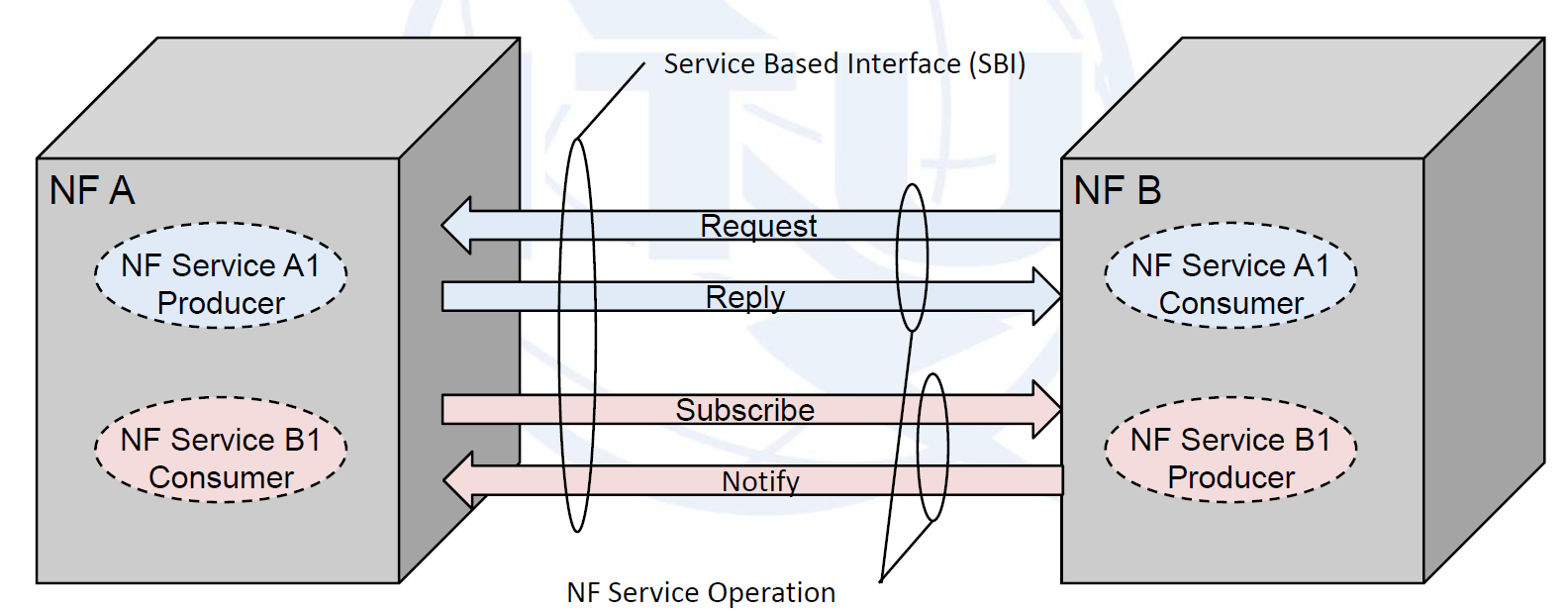
Compared to the previous generation reference point architecture as EPC, the elements of service based architecture are defined to be the NF (network functions), which interconnect with the rest network functions across a single API calling interface and provide the authorized services to them. Network repository functions (NRF) allows every network function to discover the services offered by other network functions. A service is an atomized capability in a 5G network, with the characteristics of high-cohesion, loose-coupling, and independent management from other services. This allows individual services to be updated independently with minimal impact to other services and deployed on demand. A service is managed based on the service framework including service registration, service authorization, and service discovery. It provides a comprehensive and highly automated management mechanism implemented by NRF, which greatly reduces the complexity of network maintenance. A service will interact with other services in a light-weight manner, e.g. API invocation.
Virtualization and cloud computing have resulted in lowering the cost of computing by pooling resources in shared data centers.
- 5G core networks can be shrunk in size by using virtualization. Varies components of the core network can be run as communicating virtual machines.
- Moving the control plane of the 5G core network to a cloud provider lowers the deployment cost.
The 5G core is a mesh of interconnected services as shown in the figure below:
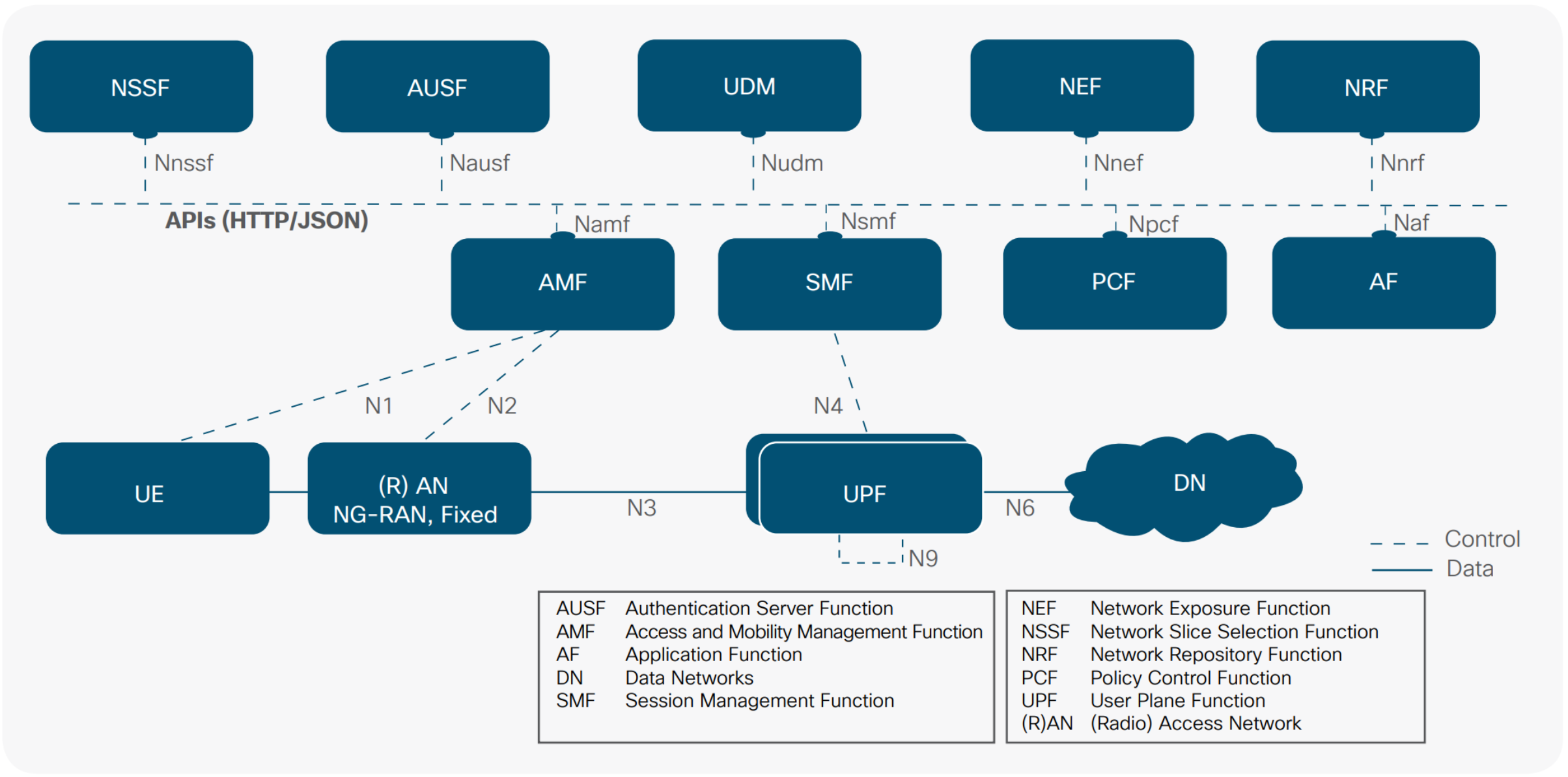
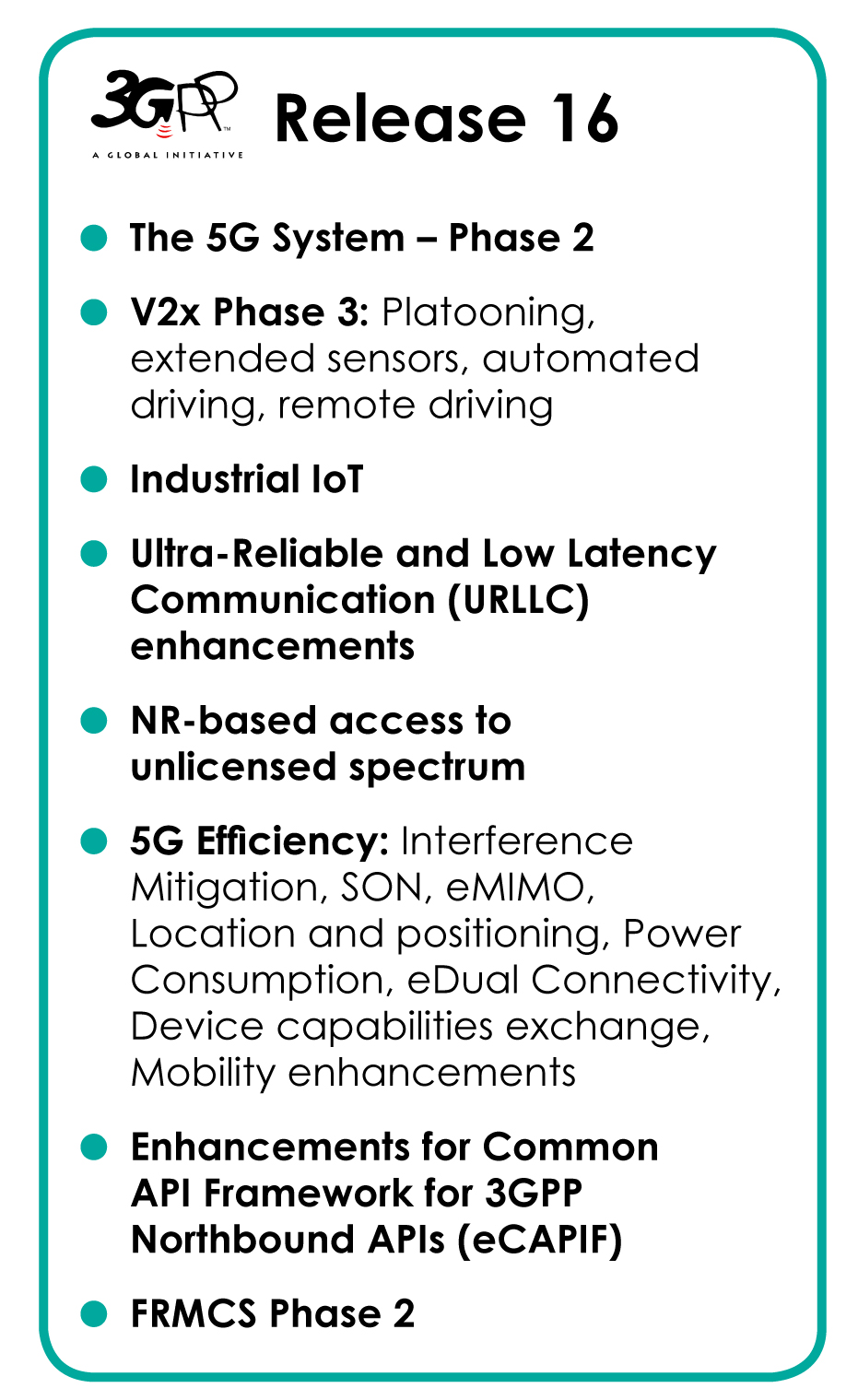
…………………………………………………………………………………………………………………………………………………………………………………………………………..
Ericsson Addendum:
According to Ericsson’s latest Mobility Report, published earlier this week, global 5G subscriptions will exceed 2.6bn within the next six years and by that time Ericsson predicts that 5G will cover 65 percent of the world. It also believes that total mobile subscriptions, including to previous generation networks, will reach 8.9bn from 8bn over the next six years. More than quarter of the global subscriptions will be 5G by 2025 and will account for around 45 percent of worldwide mobile data traffic.
Additionally, Ericsson has also announced its partnership with NVIDIA in order to develop technologies that will enable communication service providers to build virtualized 5G radio access networks, which will boost the introduction of new AI and IoT-based services. The ultimate focus will be to commercialize virtualized RAN technologies to offer radio networks with flexibility and ability to enter the market in a shorter time for new services like VR, AR and gaming.
References:
https://www.itu.int/dms_pub/itu-t/opb/tut/T-TUT-HOME-2018-2-PDF-E.pdf
https://www.3gpp.org/ftp/Specs/archive/23_series/23.501/
https://www.ericsson.com/en/portfolio/digital-services/cloud-core/cloud-packet-core
https://medium.com/5g-nr/5g-service-based-architecture-sba-47900b0ded0a
3GPP Release 16 Update: 5G Phase 2 (including URLLC) to be completed in June 2020; Mission Critical apps extended
NOTE: This article is intended as a reference, which is especially important to debunk claims made about current pre-standard 5G deployments which are almost all based on 3GPP Release 15 “5G New Radio (NR)” for the data plane with LTE signaling and LTE mobile packet core (EPC) for Non Stand Alone (NSA) operation. 5G pundits continue to site 3GPP as the standards organization responsible for 5G which is doubly wrong because it’s not a standards body and submits its 5G/IMT 2020 proposals to ITU-R WP 5D via the latter organizations member entities. As we’ve stated many times before, ITU-R is responsible for the radio standards for IMT 2020, while ITU-T is working on the non-radio aspects of IMT 2020.
………………………………………………………………………………………………………………………………………………………………………………………………………………..
Summary:
3GPP Release 16 is a major release for the project, because it will bring the specification organization’s IMT-2020 RIT/SRIT submission (to ITU-R WP 5D) for an initial full 3GPP 5G system to its completion. Release 16 will be put in a “frozen” state in March 2020 with a targeted completion date of June 2020.
3GPP work has started on approximately 25 Release 16 studies, which cover a variety of topics: Multimedia Priority Service, Vehicle-to-everything (V2X) application layer services, 5G satellite access, Local Area Network support in 5G, wireless and wireline convergence for 5G, terminal positioning and location, communications in vertical domains and network automation and novel radio techniques. Further items being studied include security, codecs and streaming services, Local Area Network interworking, network slicing and the IoT.
Here are the new features planned for 3GPP Release 16:
Details of the features and work items under each 3GPP Release are kept in the corresponding, on-line, list of features and study items.
- Enhancement of Ultra-Reliable (UR) Low Latency Communications (URLLC)
- 5GS Enhanced support of Vertical and LAN Services
- Cellular IoT support and evolution
- Advanced V2X support
- 5G Location and Positioning Services
- UE radio capability signalling optimization
- Satellite Access in 5G
- Enablers for Network Automation Architecture for 5G
- Wireless and Wireline Convergence Enhancement
- Mission Critical, Public Warning, Railways and Maritime
- Streaming and TV
- User Identities, Authentication, multi-device
- (Network) Slicing
- Other cross-TSG Release 16 Features
- NR-related Release 16 Features
- Release 16 Features impacting both LTE and NR
- LTE-related Release 16 Features



From 3GPP’s July 18, 2019 Webinar:
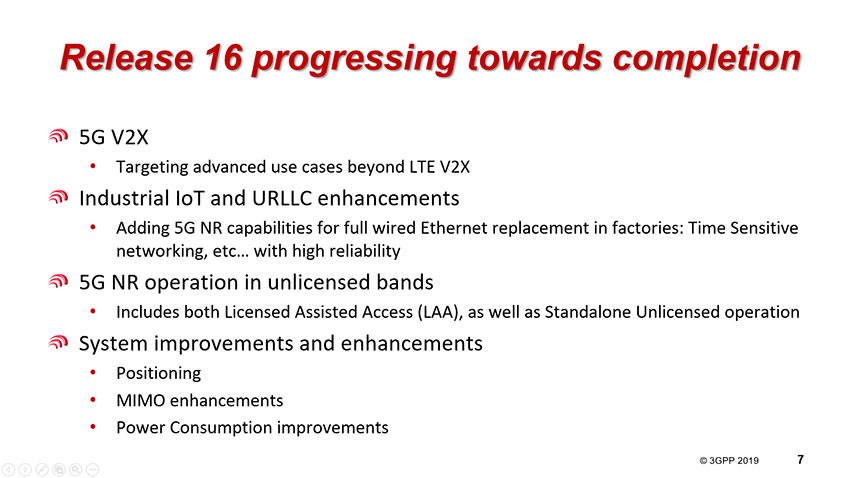

“For the (industry) verticals, there are three distinct pillars that we are focused on: Automotive, Industrial IoT and Operation in unlicensed bands. For 5G based V2X, which builds on the two iterations of the LTE-V2X, we are now adding advanced features – primarily in the area of low latency use cases.
The second focus is industrial IoT and URLLC enhancements. Factory automation, in particular, is a strong pillar for 5G going forward. We are trying to ensure that the radio side covers all of the functions that all the verticals need for factory automation. What this means in practice is that we are trying to make sure 5G NR can fully replace a wired ethernet – currently used – by adding time sensitive networking and high reliability capabilities.
The third pillar is operation in unlicensed bands. We have seen different schemes for generic 5G licensing strategies in Europe and in other parts of the World. We have seen in some countries that certain licensed bands have been allocated for vertical use cases, though that is not the case for a majority of countries. The use of unlicensed bands provides a great opportunity – where licensed spectrum is not an option. We are now focused on not only what we have with LTE, which is the licensed assisted access scheme, but also on standalone unlicensed operation – to be completed in Release 16.
Release 16 also delivers generic system improvements & enhancements, which target Mobile Broadband, but can also be used in vertical deployments – Particularly; positioning, MIMO enhancements and Power consumption improvements.”
………………………………………………………………………………………………………………………………………………………………………………………………….
Technical Reports (the result of the study phase) are also being developed on broadening the applicability of 3GPP technology to non-terrestrial radio access (initially satellites, but airborne base stations are also to be considered) and to maritime aspects (intra-ship, ship-to-shore and ship-to-ship). Work also progresses on new PMR functionality for LTE, enhancing the railway-oriented services originally developed using GSM radio technology that is now nearing end of life.
As part of Release 16, Mission Critical (MC) services will be extended to address a wider business sector than the initial rather narrow public security and civil defense services for which they had originally been developed. If the same or similar standards can be used for commercial applications (from taxi dispatching to railway traffic management, and other vertical sector scenarios currently being investigated), this would bring enhanced reliability to those MC services through wider deployment, and reduced deployment costs due to economies of scale – to the benefit of all users.
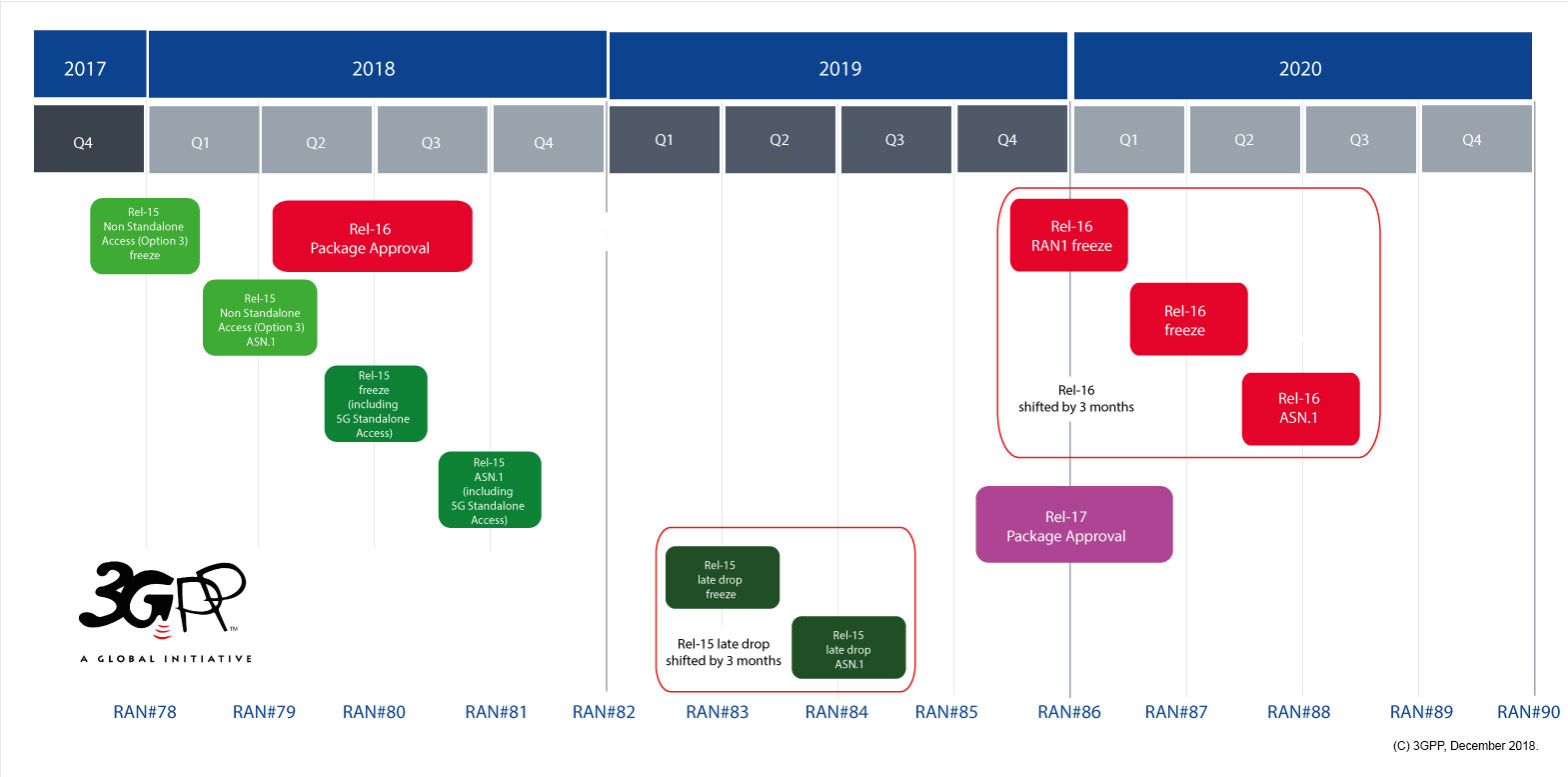
IMT-2020 – Final submission
- Calibration for self evaluation
- Prepare and finalize initial description template information that is to be submitted to ITU-R WP 5D#29.
Step 2: From early 2018 to Sep 2018, targeting “update & self eval” submission in Sep 2018
- Performance evaluation against eMBB, mMTC and URLLC requirements and test environments for NR and LTE features.
- Update description template and prepare compliance template according to self evaluation results.
- Provide description template, compliance template, and self evaluation results based on Rel-15 in Sep 2018.
Step 3: From Sep 2018 to June 2019, targeting “Final” submission in June 2019
- Performance evaluation update by taking into account Rel-16 updates in addition to Rel-15
- Update description template and compliance template to take into account Rel-16 updates in addition to Rel-15
- Provide description template, compliance template, and self evaluation results based on Rel-15 and Rel-16 in June 2019.
Some Background on Release 16
- See the full Release 16 Description – TR21.916 (Available at Release freeze)
- RAN Rel-16 progress and Rel-17 potential work areas (July 18, 2019)
- Early progress on Rel-16 bands for 5G (April 2, 2019)
- “Working towards full 5G in Rel-16”…See 3GPP webinar presentation (July 3, 2019)
- Preparing the ground for IMT-2020
- SA1 completes its study into 5G requirements
……………………………………………………………………………………………………………………………………………..
References:
https://www.3gpp.org/release-16
https://www.3gpp.org/news-events/2058-ran-rel-16-progress-and-rel-17-potential-work-areas
…………………………………………………………………………………………………………………………………………………………………………………………………….
Addendum (December 14, 2020):
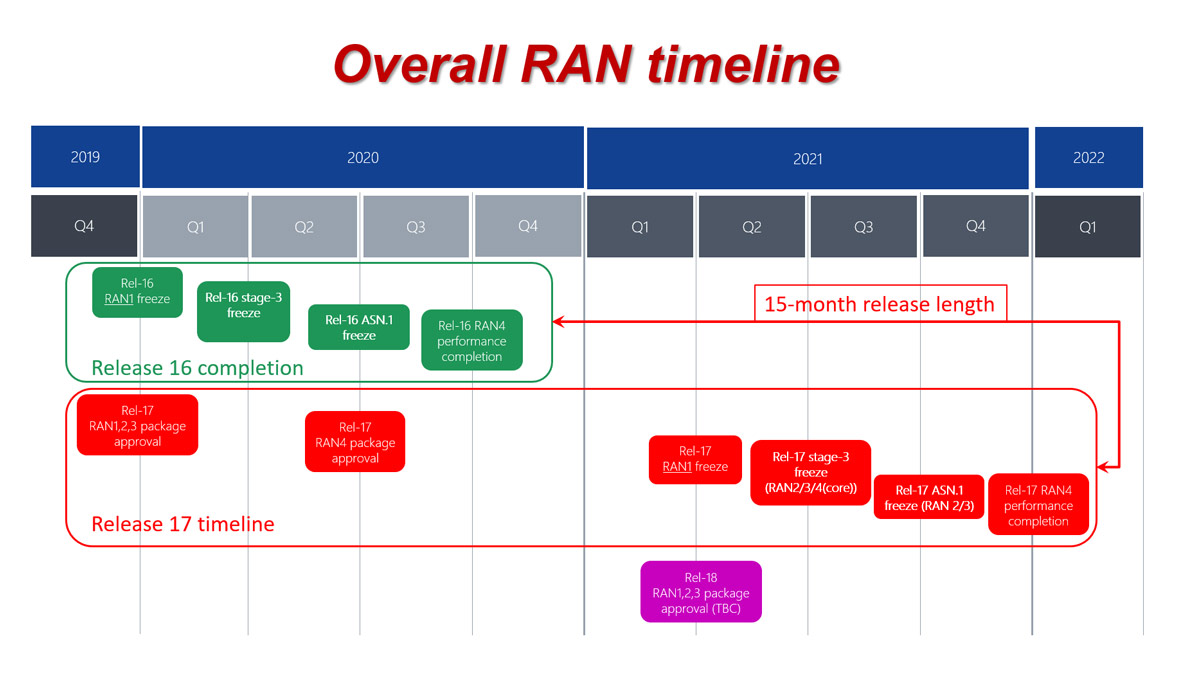

https://www.3gpp.org/news-events/2098-5g-in-release-17-%E2%80%93-strong-radio-evolution


